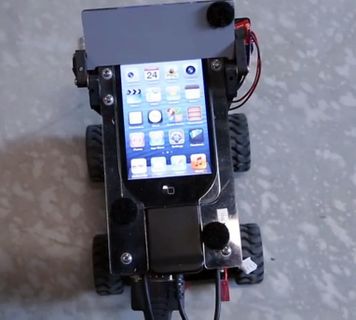Recent News
UNM Engineering names Prabhakar inaugural Cleve Moler and MathWorks Endowed Chair
October 3, 2025
Computer scientist wins Athlete of the Year Award for adaptive skiing technique
May 29, 2025
Hand and Machine Lab wins 2 awards at CHI conference
May 15, 2025
News Archives
Turning tiny robots into student recruiters (UNM NewsRoom)
April 24, 2015
iAnts demonstrate complex behavior
By Karen Wentworth —
 How do you excite high school students about the possibilities of computer programming? One way is to show the results. That’s why this group of students from Nex+Gen Academy in Albuquerque is in the basement of the University of New Mexico's Centennial Engineering Center watching iAnts.
How do you excite high school students about the possibilities of computer programming? One way is to show the results. That’s why this group of students from Nex+Gen Academy in Albuquerque is in the basement of the University of New Mexico's Centennial Engineering Center watching iAnts.
The iAnts are tiny robots made from iPods, placed on wheels, and programmed to behave the way real ants do. They swarm around a lantern in the middle of a room that represents the nest. The bright light is used to help cameras on the iAnts locate the nest.
Paper QR codes scattered around the floor represent food. When one of the ants rolls over a code, it scans the code, returns to the nest and communicates with others to tell them of the find.
Computer Science Associate Professor Melanie Moses has studied ant colonies to understand how they work together for the good of the group. She is fascinated by the way ants balance independent work, with cooperative tasks, but without any hierarchy to direct them.
The iAnts mimic many behaviors of real ants. They have been programmed to work cooperatively, but without any leader. She and her students are building simulations to explore how real ants might perform when they are given tasks.
Video by Ryan Montano
Students do much of the actual programming with the iAnts. Joshua Hecker, a Ph.D. candidate in Computer Science leads the iAnt research. He sets challenges for the team of undergraduates who each tackle a different aspect of the problem.
Antonio Griego, a junior in Computer Science at UNM programmed a simulation that visualizes how the iAnts actually interact with each other and the obstacles in their environment. The visualization allows students and researchers to see how parameters of the model can change the number of tags that are found and the number of collisions that occur between robots.
“Ants are unique ecologically,” she says. “There might be 20 million ants in a colony. They have no foreman, no blueprints, no one in charge. They may have a single queen. They may have multiple queens.” But somehow they are able to working cooperatively to do the many tasks required to successfully support the colony.
 Moses says structure emerges from interaction among components and between components and their environment in ant colonies. Understanding how structure emerges from interactions is the kind of complex problem guaranteed to keep generations of UNM computer science students engaged.
Moses says structure emerges from interaction among components and between components and their environment in ant colonies. Understanding how structure emerges from interactions is the kind of complex problem guaranteed to keep generations of UNM computer science students engaged.
Moses is also helping to expand a program in called the “NM Computer Science For All” initiated by the Santa Fe Institute in collaboration with UNM, into a permanent part of the curriculum in New Mexico high schools. Teachers from Deming, Ft. Sumner, Gadsden, Gallup McKinley, House, Las Cruces, Los Alamos, Rio Rancho, Socorro, Taos, West Las Vegas, Zuni, the Bureau of Indian Affairs Southern Navajo Agency and some charter schools in Albuquerque have already been trained in the curriculum. The project was initially funded by the National Science Foundation.
Much of the curriculum for Computer Science for all is online at the CS4all webside. A course (CS590) to prepare high school teachers will be offered online at UNM this summer. There will also be an offering of CS4all (CS108) available for UNM students and as dual credit for high school students offered on UNM campus this summer.
